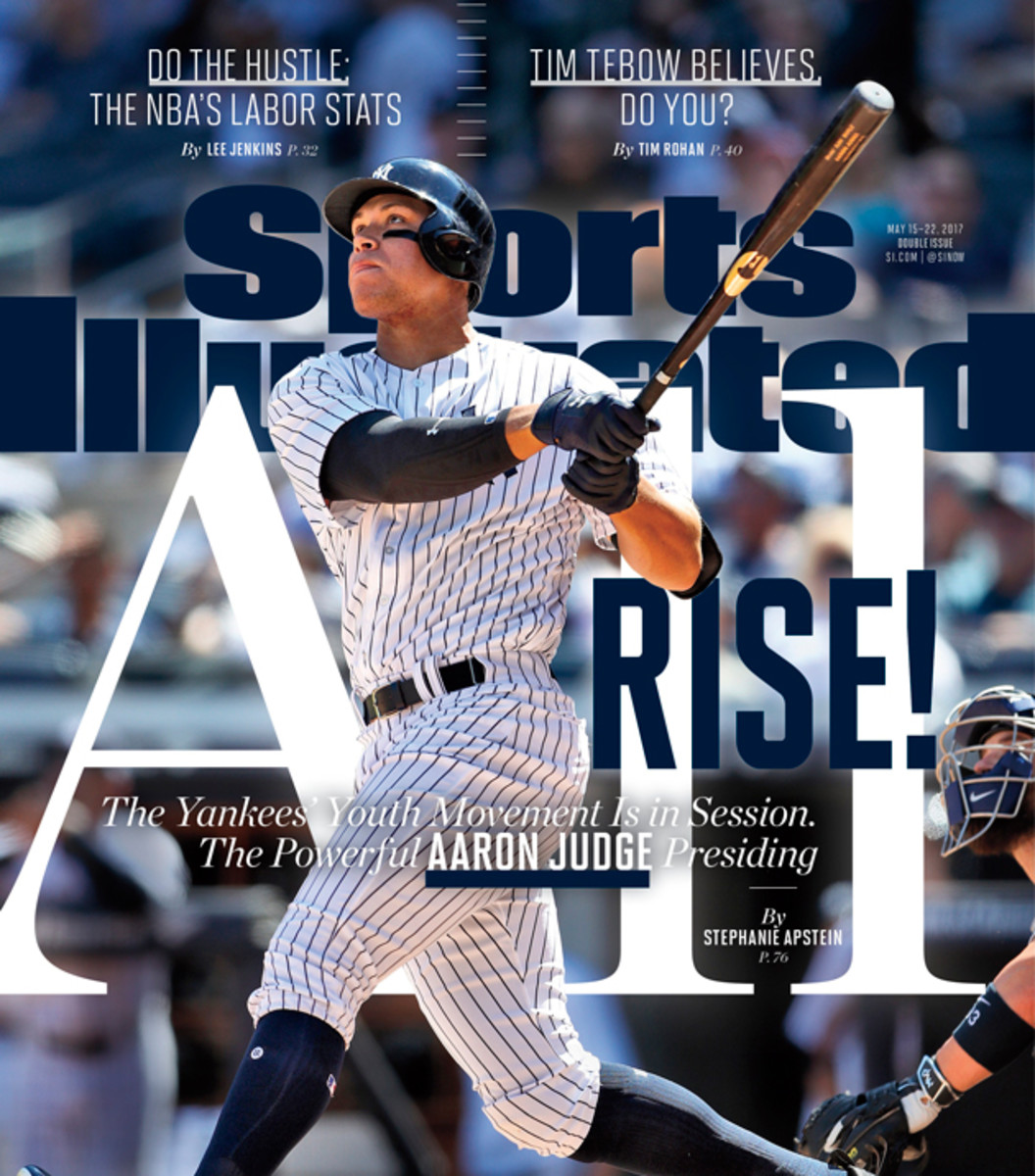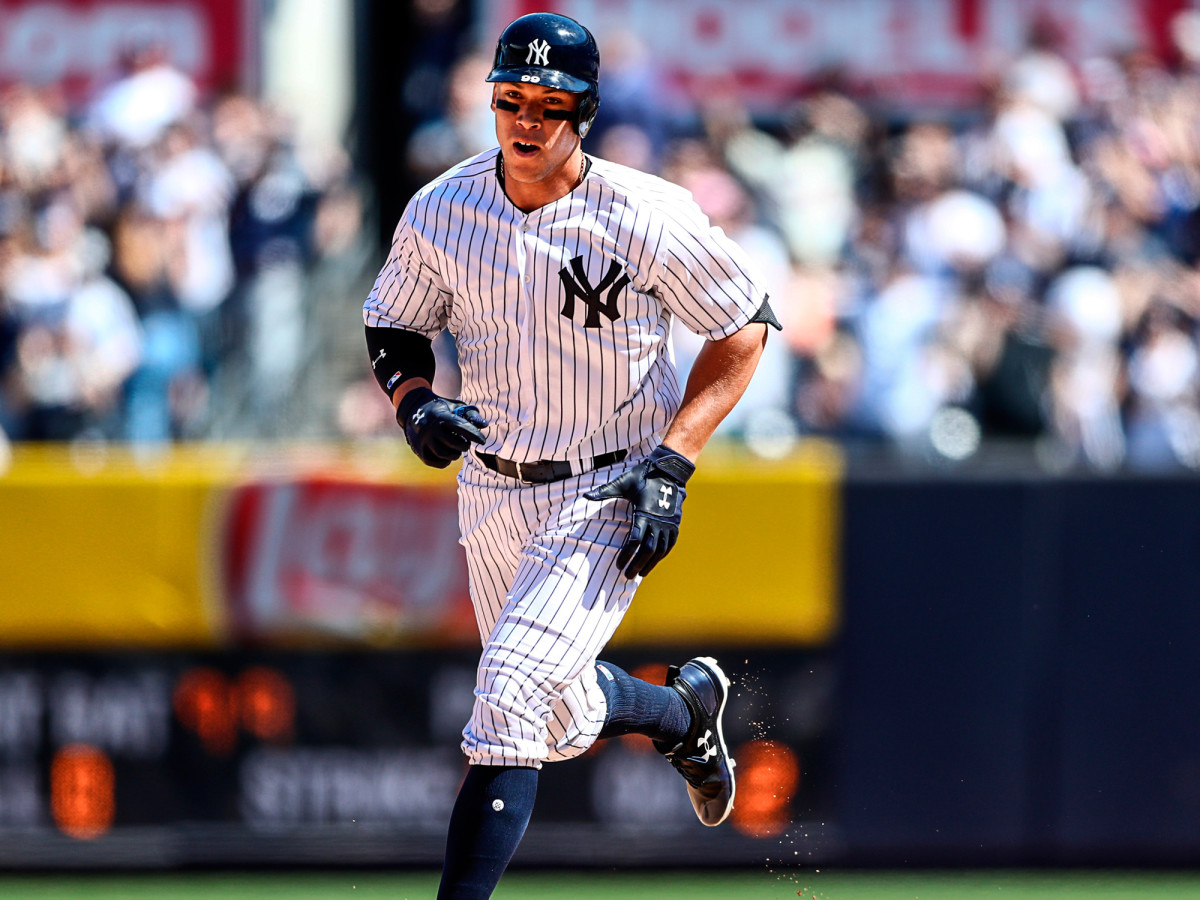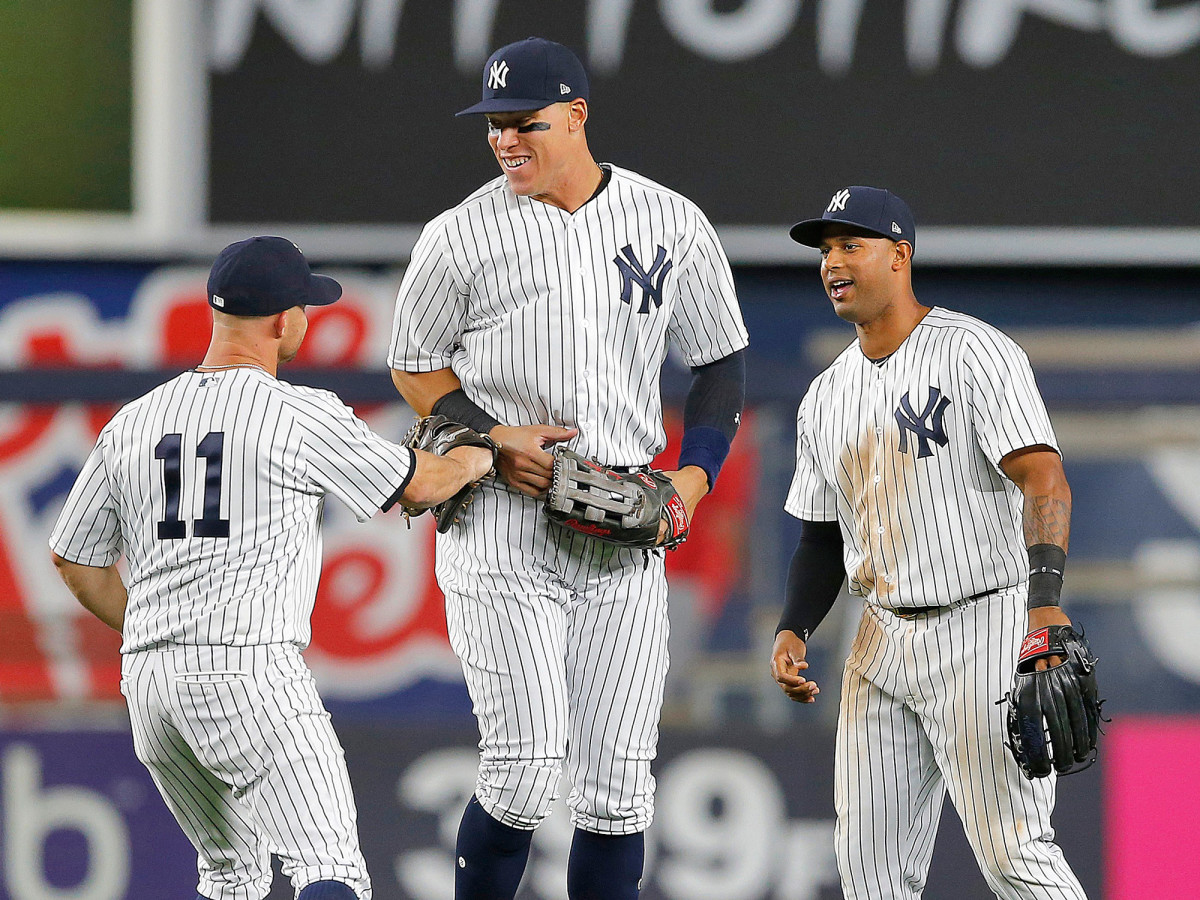Powerful Yankees slugger Aaron Judge stands out, but all he wants to do is blend in

This story appears in the May 15 issue of SPORTS ILLUSTRATED. To subscribe to the magazine, click here.
People keep asking Aaron Judge:What is life like now that everyone knows you? He has a hard time answering that question. Everyone has always known him.
As a child growing up with his teacher parents and older brother in Linden, Calif., a no-stoplight pinprick of an agricultural town 100 miles inland from San Francisco, he could go weeks without encountering a stranger. By the time he enrolled at Fresno State, he was a star outfielder who drew stares every time he entered a room. There is nowhere for a 6' 7", 282-pound man to hide. He is used to the feeling of eyes on him.
Perhaps the biggest difference is how often people approach him, though he always got some of that, too. “You’re huge!” passersby would say. “What do you play?” He’d grin and answer, “Fantasy football,” before fessing up. Today the questions tend to be requests, usually for photos. He tries to agree to them all. “That could be the only time they meet me,” Judge says. “I don’t want to leave the impression that I didn’t have the five seconds to say hello.”
When they see him, fans like to inform him, “You’re Aaron Judge!”
He doesn’t need to introduce himself to opposing teams, either. The Yankees’ rightfielder and biggest Baby Bomber—indeed, the biggest position player, by body mass, in MLB history—is off to the most powerful start to a season ever by a rookie, with 13 home runs in his team’s first 29 games. Dr. Seuss could have written his April:
Judge hits them on pitches fast and pitches slow
He hits them on pitches high and pitches low
He hits them on pitches that break out and pitches that break in
He hits them on pitches that fly straight and pitches that have spin
Judge hits them here, he hits them there,
He hits home runs everywhere.

And he hits them hard. Through Sunday, 26 balls had left major league bats at speeds of 115 mph or faster; Judge was responsible for nine of them. A 119.4-mph screamer last month set the record for hardest-hit homer since MLB’s Statcast system began tracking such things in 2015. His shots average 406 feet; the longest so far, a solo blast against the Pirates in Pittsburgh, measured 457. He can extend his arms and shoot lasers into the leftfield stands; he can get jammed on a high fastball and inside-out it over the wall in dead center.
He leads the American League in almost every offensive category, from those homers to runs (28) to WAR (2.5). His plate appearances snap fans to attention, in part for their own safety; last week he took out a TV in the Yankee Stadium outfield terrace during batting practice. When New York trails entering the ninth inning, no matter where Judge awaits in the lineup, the announcers start doing the math. If just one of them gets on base . . . Barring a double play. . . . As Judge lurks in the righthanded batter’s box and outfielders backpedal, fans shower him with MVP chants. The Yankees, widely thought in spring training to be a year away from contention, held the best record in baseball at week’s end.
'Windows close fast': For Matt Harvey and the Mets, it may soon be time to move on
Manager Joe Girardi has cited Derek Jeter to describe Judge’s demeanor. Broadcasters gush that his bombs are Ruthian. And his attitude toward fans recalls Joe DiMaggio’s famous line: “There is always some kid who may be seeing me for the first or last time. I owe him my best.”
Maybe we should have seen this coming: Judge did homer in his first major league at bat last August. But then he went 14 for his next 83 with three more home runs and 42 strikeouts. That was the kind of performance scouts had feared in the run-up to the 2013 draft. There’s a reason most people who look like Judge can’t hack it at the highest level: They hack at the highest level. “The strike zone is just so big,” explains Yankees national scout Brian Barber. “Can he reach the pitch outside? Can he get the bat on the pitch inside?” New York had two extra first-round picks that year and decided to use one, the 32nd, on a guy with a low floor but a very high ceiling.
Judge spent the off-season realizing that a man with his strength does not have to hit every ball perfectly. (“It doesn’t matter what row it lands in,” Yankees special assistant Jim Hendry likes to say.) He flew to New York City in January and spent three days taking private lessons from hitting coach Alan Cockrell. They worked on stabilizing his lower half, but the main focus was approach. Judge was always a patient hitter; he just needed to do a better job of identifying which pitches he could sentence to the bleachers. Last year he struck out 44.2% of the time; through Sunday it was 26.5%. At the same time, his slugging percentage has more than doubled, from .345 to (a likely unsustainable) .772. The Yankee Stadium jumbotron now displays a gavel graphic and the words all rise before Judge’s first at bat of each game. At this point, fans might as well remain standing until he’s done.

*****
Judge does not live quite the life you might imagine for a 25-year-old star of the most storied franchise in sports. His first visit to New York City was the day he was drafted; his second came on the day he was called up. He spent the end of a recent homestand in leftfielder Brett Gardner’s guest room in Armonk, 30 miles north of the city, but otherwise he lives out of two suitcases in an Art Deco hotel in the heart of Times Square.
Why hasn’t he looked for an apartment yet? “I don’t want to put all my cards that I’m going to be in New York and then I go to Triple A,” says the major league home run leader. “Maybe next year, if everything goes well.”
Gray Area: How baseball is taking steps to confront its complex racial future
His lobby is one of the few places he can watch people, tourists who aren’t watching him. He hears a different language seemingly every time he rides the elevator. This place could not be less like Linden. But his favorite part of the Times Square location, he explains eagerly, is that “if I want to get frozen yogurt at 12 o’clock at night, I can do it.” He celebrated his most recent birthday, on April 26, by hitting the homer that would be the difference in the Yankees’ 3–1 win over the Red Sox, tumbling into the Fenway Park stands to hold on to a foul ball and then going to bed early. He says he has not yet been to a bar in New York City.
“I have a very short window to play this game,” he says. “The last thing I want to do is waste it being out on the town. I want to get every ounce I can out of my body.”
That body has always been prodigious. After dominant Little League performances, adults would quiz him on his age. He began to imagine a future in which he made the majors, but the picture was just an outline. He starred in three sports as a teenager, setting the Linden High record for touchdowns as a wide receiver and scoring 18.2 points per game as a basketball center, but he always loved baseball most. Back then he didn’t quite understand why. Today the reason is clear to him: because it’s hard.
“You can’t just enjoy the positives,” he says. “You gotta enjoy the negatives. I don’t like going 0 for 7. I don’t like striking out—no one does—but you can’t have the good without the bad. The most important thing is when you have those bads, make sure you learn from them. Don’t come in here and slam your helmet and start cussing. Because the game’s not going to stop. Pause the game, Aaron’s upset, give him 15 minutes to calm down and we’ll replay it once he’s ready to go. If I wanted to bat a thousand and hit home runs every time I came to the plate, I’d go be a professional Little League player.”
He enjoys the grind of 162 games in 183 days. He likes that he never knows what day of the week it is, instead tracking time by the beginnings and ends of series. Baseball rewards dedication to a process, and Judge loves the process.

*****
Many teams have some version of a kangaroo court—a system of fines to punish lateness or carelessness or poor fashion sense—but Fresno State’s is a little different: Players have to put a dollar in the shoebox every time they use the words I, me or my boastfully. Hit a walk-off bomb? The team played a great game. Ace a test? The professor prepared us well. It’s a hard rule to remember; everyone slips up at least a few times a season. In three years as a Bulldog, Judge was never fined.
All teams obsess over character when scouting amateurs. The Yankees aren’t looking for anything the Brewers don’t covet too. But there’s a much smaller margin for error in the fishbowl of New York City. (“If you’re not humble,” Jeter tells young players, “this town will humble you.”) The Yankees loved Judge’s size and swing and athleticism—between his surprising speed and cannon of an arm, he should stick in rightfield—but a key was their belief that they had found someone who could handle enormous pressure by thinking small.
“The big thing for me this year is trying to have your moment for the game,” he says. “Every time I go up there to hit, I feel like that’s going to be my moment. Say I get out, O.K., I move on and I’m going to try to do something on defense. If nothing happens there, I come in here and cheer somebody on to go do their best. . . . I might go 0-for-4, but my impact might be helping out a teammate who’s down in the dumps.”
Judge makes sure he arrives early enough to use the batting cage before the rush, stays out of the training room during the veterans’ preferred times and generally keeps his mouth shut. Every year in spring training, the Yankees run their young players through close to 10 hours of media coaching. In preparation for Judge’s likely expanded role this season, p.r. director Jason Zillo pulled him aside and tried to trap him in a cocky or poorly-thought-out comment. Finally he called GM Brian Cashman. “There’s nothing more I can do,” Zillo said. “He’s good.”
Trea Burner: The Nationals' shortstop is blazing a path to success one steal at a time
Should his attitude ever exceed his standing, though, Judge can count on his sometimes roommate to keep his size-17 feet planted firmly on the grass. Gardner needles teammates and clubhouse guys alike, but he takes special pleasure in going after Judge. One minute he’s swiping a bag of sunflower seeds out of the rookie’s big hands and throwing it onto the field; the next he’s speculating about hiding a camera in the guest room to record himself pranking his friend. “He started it!” Gardner insists. “The other day he dumped a bucket of cold water on me in the shower. Unprovoked!” Judge just grins like a freshman on whom the seniors have bestowed a nickname.
This life that he sketched for himself is so much better with the details filled in. Every day he gives himself an extra few minutes during pregame warmups just to stand in rightfield and gaze at the tens of thousands of seats that will soon fill with fans screaming his name.
Maybe he will hit a home run. (Maybe he will hit four.) Maybe he will nail a runner at the plate or extend his frame to rob a homer that no one else in baseball history could reach. Maybe he will say just the right thing to a slumping teammate, who will then work a walk that leads to a late rally, and to Judge that will be as good a result as any of the others. Or maybe he will make a crucial mistake, but he’ll push past his distress and find a way to learn from the moment.
Either way, afterward he will take a cab to Times Square, where he will navigate past Elmo and Iron Man and an ocean of tourists. He will collapse into bed in his junior hotel suite, and he will fall asleep to the sound of horns and sirens and shouts in a city that is beginning to feel like home.
